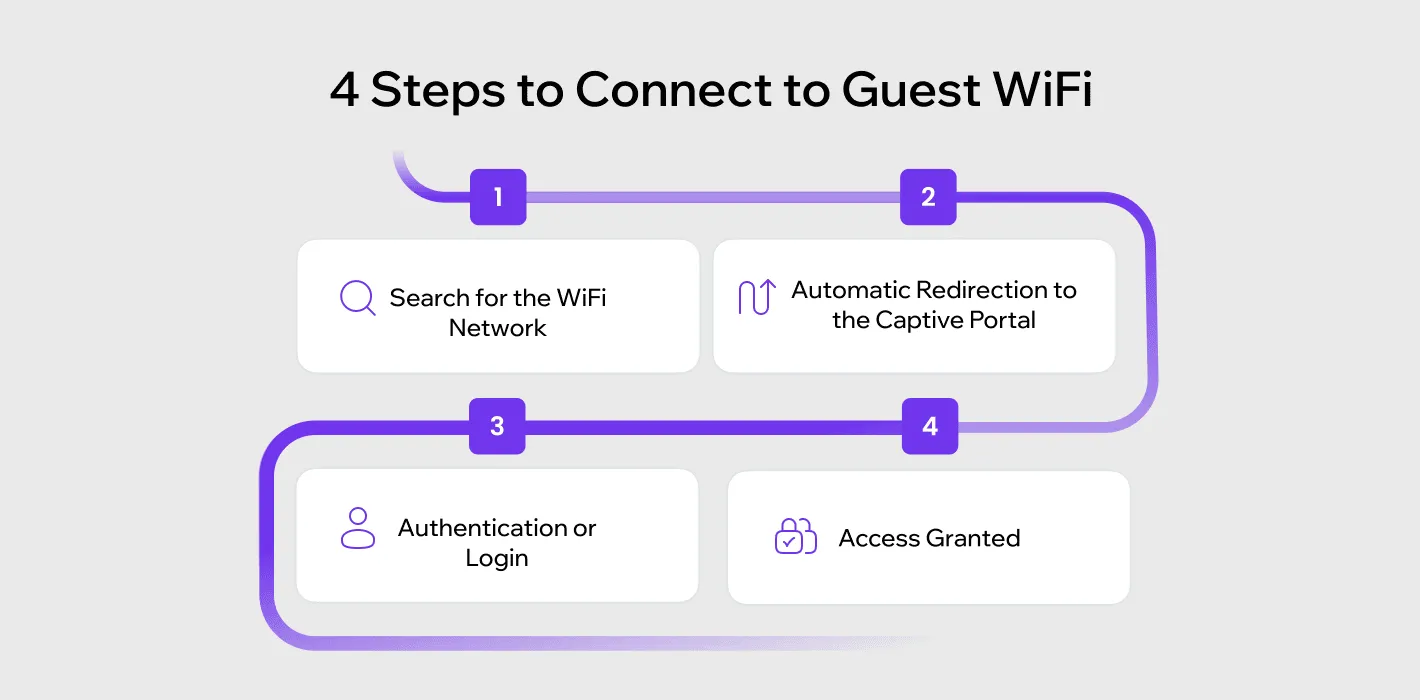

Slow or unreliable connections can leave a lasting negative impression - no matter how polished the rest of their experience feels.
So, you must have a guest WiFi network that meets your guests’ demands. These demands can include everything from an easy login process to secure connectivity and personalization options.
To provide all the above, you need to set up a strong guest WiFi network. This requires finding the right balance between speed, security, and ease of use. While it may seem challenging, creating a dependable system is simpler with a clear plan. So let’s make one together.
In this article, you’ll find tips to configure a WiFi network that guarantees flawless connectivity, protects your guests’ data, and meets modern travellers' tech requirements.
Hotel Guest WiFi is the wireless internet service provided by hotels specifically for their guests. It allows visitors to connect their devices (smartphones, laptops, and tablets) to the internet during their stay.
Guest WiFi is typically separated from the hotel’s internal network for security and can be managed through features like captive portals, bandwidth controls, and usage analytics. Reliable guest WiFi is considered an essential amenity. It supports browsing, streaming, video calls, and smart hotel technologies. In simple words, correctly managed guest WiFi has the power to improve overall guest satisfaction.
 Although this process may vary for different guest WiFi solutions, here is the main step chain that hotel guests need to go through to connect to the hotel WiFi.
Although this process may vary for different guest WiFi solutions, here is the main step chain that hotel guests need to go through to connect to the hotel WiFi.
Step 1. Search for the WiFi Network Starting with the basics. Guests open the WiFi settings on their device and select the hotel’s guest network (often named after the hotel).
Step 2. Automatic Redirection to the Captive Portal
After connecting, the device redirects to a login or welcome page.
Step 3. Authentication or Login
Guests may need to do one of these:
Step 4. Access Granted
Once authenticated, the guest is granted internet access with bandwidth and speed defined by the hotel (basic or premium tiers, if available).
After the guests successfully access the hotel's WiFi, the system focuses on keeping guest devices on a separate network from hotel operations to prevent risks. The network continuously tracks performance, usage, and peak times to ensure smooth connectivity.
Setting up guest WiFi in your hotel requires careful planning to meet both operational demands and guest expectations. Your goal is to design a network with smooth connectivity that protects your business from potential security risks.
Here are five key factors to keep in mind:
1. Bandwidth and Speed Requirements
Assess your guests’ internet needs to determine the bandwidth and speed required for smooth browsing, streaming, and video calls.
Network Security
With cyberthreats on the rise, securing your network is critical. Use firewalls, encryption, and secure login methods to safeguard guest data and prevent unauthorized access to your guest WiFi system.
2. Accessibility and Coverage
Ensure WiFi is available throughout the property, from guest rooms to common areas and meeting spaces. One way to do this is to conduct a site survey to identify weak spots and add access points as needed to ensure reliable connectivity throughout the site.
3.User Authentication and Access Control
Implement strong authentication systems to restrict guest WiFi access to unauthorized users. This way, you get to protect the network, enable usage monitoring, and help manage bandwidth for consistent performance.
4.Scalability and Future Needs
Plan for future growth and technological advancements like IoT devices and smart room systems. Choose a scalable guest WiFi solution that can adapt to your hotel’s evolving demands and ensure seamless upgrades as guest expectations change.
To create a reliable and efficient guest WiFi system, you need to start by selecting the right equipment. The routers, access points, and networking devices you choose will directly impact the speed, reliability, and overall performance of your network.
Begin by assessing the size of your hotel and the types of devices your guests are likely to use. High-traffic areas like lobbies, conference rooms, and other communal spaces require advanced access points capable of handling multiple connections simultaneously without lag.
Since spotty WiFi is one of the biggest frustrations for hotel guests, ensure your equipment delivers seamless coverage across multiple floors and diverse room layouts. Opt for devices that support essential security features. These include robust firewalls, guest network isolation, and data encryption. This way, you’ll protect both your operations and guest data.
For hotel environments, commercial-grade equipment is a better choice than consumer-grade devices. It offers superior performance, durability, and security. Many commercial guest WiFi solutions also come with centralized management tools, allowing you to monitor and control the network through a single interface. These tools make it easy to manage bandwidth, set access controls, and apply updates - even without in-house technical expertise.
To create a secure, efficient, and reliable guest WiFi network, you must follow a structured approach. The steps outlined below ensure smooth connectivity, protect sensitive data, and meet your guests' expectations.
Here’s how to set up a guest WiFi network that works seamlessly across your property:
Evaluate the average number of guests and devices connected during peak occupancy. Use this data to choose a hardware setup and internet plan capable of delivering fast, reliable connections for all users, even at full capacity.
Invest in high-quality routers, access points, and networking hardware designed for large-scale use. Select equipment that supports centralized management. It should also handle multiple simultaneous connections without performance issues.
Separate the guest WiFi network from your hotel’s internal systems to enhance security. This prevents guest devices from accessing administrative resources. It also protects sensitive hotel information while maintaining safe guest WiFi access.
Implement robust firewalls, enable WPA3 encryption, and use advanced security features like user authentication to protect guest data. These measures shield against cyber threats and ensure a secure browsing experience for your visitors.
Conduct thorough testing to confirm consistent speed and strong coverage across the property. Adjust signal strength, reposition access points, and monitor bandwidth to ensure the guest WiFi system delivers the dependable, high-speed internet your guests expect.
Strong security measures are essential to protect both your hotel’s systems and your guests’ data. A well-implemented security plan shields your operations from cyber threats and also builds trust with your guests.
Here is what you can do to ensure guest WiFi security:
1. Start by enabling WPA3 encryption on your guest WiFi network. This advanced security protocol prevents unauthorized users from accessing the network and secures data transmitted over the connection. It’s a foundational step to ensure safe browsing for your guests.
2. Network segmentation is another critical measure. By isolating the guest WiFi system from your hotel’s internal operations, you prevent visitors from interacting with sensitive administrative data. This separation enhances both security and performance.
3. Additionally, firewalls and intrusion detection systems add another layer of protection. These tools monitor network traffic for suspicious activity and block potential hacking or malware threats.
Tracking guest WiFi usage is key to improving network performance and understanding visitor behavior. This whole process includes monitoring connection quality, peak usage times, and device types, which reveals how guests use the network and highlights areas for improvement.
With this data, bandwidth can be allocated efficiently. Activities like video streaming, gaming, and conferencing can remain fast even during peak demand. Regular monitoring also helps resolve issues quickly, ensuring guests have a smooth WiFi experience.
WiFi analytics tools also support better engagement.
Example:
Tracking traffic on your hotel’s landing page can guide marketing efforts or highlight popular services. Understanding usage patterns helps tailor offerings to guest preferences, improving satisfaction and boosting revenue.
 Effective guest WiFi management is absolutely critical for creating happy guests and efficient hotel operations. However, there’s a lot to do, like choosing the right tools, securing your network, and delivering fast connections.
Effective guest WiFi management is absolutely critical for creating happy guests and efficient hotel operations. However, there’s a lot to do, like choosing the right tools, securing your network, and delivering fast connections.
What a good thing you don’t have to build all these from scratch. Because we already did it for you. Yes, HotelSmarters offers the perfect solution for your hospitality needs. We’ve created a hotel WiFi solution that allows twice as easy guest WiFi management with the personalization options it provides.
All you have to do is contact our specialist and get the hotel WiFi solution that can elevate your guest experience to a whole new level.
Contact HotelSmarters today to take the first step toward seamless integration and a smarter guest experience.
Co-fundador / CTO
Armen é o CTO e Cofundador da inoRain OTT e Cofundador da HotelSmarters, especializado em tecnologias avançadas de streaming, estratégia OTT e TV interativa. Ele desenvolve soluções escaláveis de entrega de vídeo e lidera inovação técnica em hotelaria e streaming, conectando engenharia complexa a impacto real nos negócios.